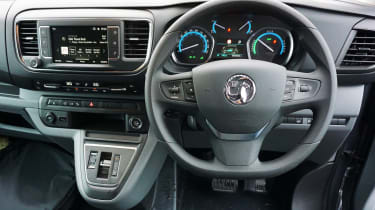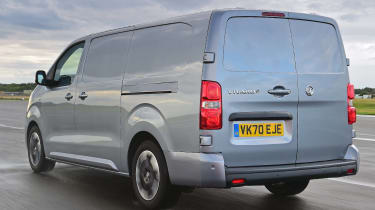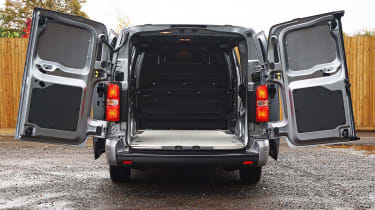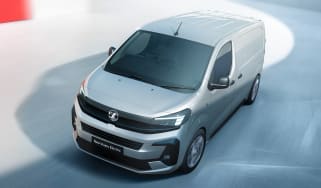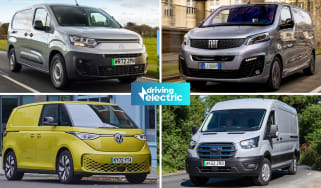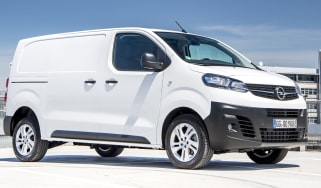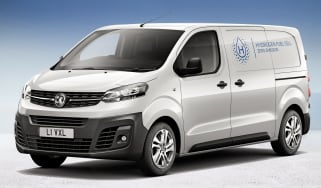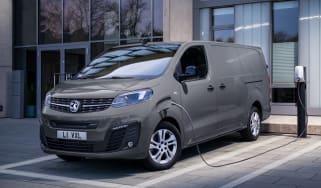Vauxhall Vivaro Electric review
The impressive Vauxhall Vivaro Electric is one of the best pure-electric vans we've driven, and offers a competitive driving range for this class
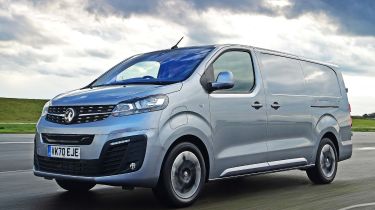
Pros
- Long driving range
- Pretty good value
- Nice to drive
Cons
- Wide-angle mirrors needed
- Cargo area not the largest
- Slow charging at home
| Battery size | Range | Wallbox charge time | Rapid charge time |
|---|---|---|---|
| 50kWh | 143 miles | 7hrs 30mins (0-100%, 7.4kW) | 30mins (0-80%, 100kW) |
| 75kWh | 205 miles | 11hrs 20mins (0-100%, 7.4kW) | 45mins (0-80%, 100kW) |
Much like their car-building counterparts, van makers have been rolling out a number of fully electric models in recent times. Where once there were only a handful of electric vans to choose from, now there are plenty more options, covering vans of many shapes and sizes. Several of them have also been designed from the start to run zero-emissions drivetrains – as opposed to being adapted from diesel-engined vans – with one of the first being the Vauxhall Vivaro Electric.
It's a sister model to the Citroen e-Dispatch, Fiat E-Scudo Peugeot e-Expert and Toyota Proace Electric, and is available with two battery sizes, 50kWh and 75kWh, which provide a driving range of 143 or 205 miles respectively, according to official testing. Both solid figures, but the electric Vivaro can't quite match the 254-mile range of the Volkswagen ID. Buzz Cargo.
You'll find the Vivaro Electric's electric motor where the engine sits in the diesel version, while the batteries are accommodated under the cargo compartment floor, so load space is identical to the diesel's. The motor and batteries are the same as those in the Vauxhall Corsa Electric supermini and its Peugeot e-208 sister model, so total power output is 134bhp, which is enough for a motorway-friendly top speed of 84mph.
As well as the choice of battery sizes mentioned above, you can pick from Prime, Pro and GS trim levels; the first gets steel wheels, black plastic bumpers, cruise control, heated wing mirrors, rear parking sensors and a seven-inch touchscreen with Apple CarPlay and Android Auto support. Pro adds car-like luxuries such as a reversing camera, body-coloured bumpers, sat nav, automatic windscreen wipers and an alarm, while the GS spec models get a sporty bodykit, black 18-inch alloy wheels and extra kit like keyless entry and climate control.
Like many of its rivals, the Vivaro Electric can be specified in different body lengths. There’s the L1 style that comes as default on all trims, and the L2 which increases the van’s length by 350mm and only comes on Prime and Pro models. Vauxhall used to offer a five-seater Doublecab version of the Vivaro Electric, which sacrificed some load space to make room for an extra row of seats, but that’s been dropped as of April 2023.
Sit inside and you'll see the Vivaro Electric is near-identical to the Vivaro diesel, although in place of the rev counter there's an energy gauge for the battery, while the gearlever has been replaced by a drive selector for switching between Eco, Normal and Power driving modes. Space up front isn't quite as generous as in some rivals, but it's far from being a tight squeeze. The glovebox is on the small side, but there's dash-top storage and the twin-passenger seat base flips up to reveal more storage underneath.
Like all electric vans, the Vivaro Electric's relatively high purchase price has to be set against the significant running-cost savings to be made compared to a diesel van. Servicing costs should be lower, too, plus the Vivaro Electric is exempt from road tax (VED) and the London Congestion Charge until April 2025 and December 2025 respectively. Being a fully electric large van, the Vauxhall is eligible for the plug-in van grant of up to £5,000, too.
By electric van standards, the Vivaro Electric is also quite reasonably priced; rivals like the Fiat E-Scudo and Toyota Proace Electric are in the same ballpark, but more upmarket alternatives are, perhaps unsurprisingly more expensive. An entry-level Mercedes eVito is knocking on the door of £50,000, for instance.
City centres are where electric vans like this are at their best; while they're perfectly capable of taking to the motorway, sustained running at 60 to 70mph, especially with a full cargo bay, will see the potential range drop significantly, so this is not really a vehicle for regular long-distance runs.
When it's time to charge, you can use a wallbox at home or at a business premises, but at a maximum speed of 7.4kW this is best reserved for overnight charging; it'll take over seven hours to replenish the 50kWh battery and more than 11 hours to do the same for the 75kWh unit. For quicker top-ups while out and about, the Vivaro Electric has up to 100kW DC rapid-charging capability – enough to get the smaller battery from near-empty to 80% in half an hour, and the larger to the same capacity in just over 45 minutes.
Turning to load space, two body lengths are available (called L1 and L2), but at the moment there's no variation in roof height, and the standard height is on the low side compared to some rivals. The rear double doors and sliding side doors don't offer the widest access to the cargo area, either, so while the van might have enough room inside for a very tall item, the height and width of the doors might prevent you from carrying it in the first place. The Vivaro Electric does at least fare well with hauling longer items: the load lengths for L1 and L2 versions are 2.51 and 2.86m respectively, and this is extended by another 1.16m on models with the optional load-through hatch.
Cargo volume is unchanged compared to the diesel Vivaro, at 5.3 cubic metres in the L1 and 6.1 cubic metres in the L2, but the electric model can't quite match the diesel's maximum payloads, managing about 200kg less in all instances. The Vivaro Electric’s towing capacity of 1,000kg is massively down on the combustion-engined models, too, which can haul between 1,800kg and 2,500kg depending on the spec.
To drive, the Vivaro Electric is much more refined than its combustion-engined counterpart, as the electric motor is so much quieter than a diesel engine. Tyre and wind noise do become evident at higher speeds, but it's far from deafening. The van is also very simple to drive; you simply press the starter button on the dashboard to bring the electric motor to life and it's ready to roll away. Light steering makes manoeuvring around town a breeze, while the weight of the batteries makes the rear axle less susceptible to bouncing around when the load bay is empty.
The three driving modes mentioned above feel noticeably different: Eco limits use of climate control and dulls the throttle response considerably in order to achieve maximum range, while Normal is perfect for everyday use, giving strong acceleration to around the 40mph mark. Power is useful for when the van is heavily loaded, but does hit range quite considerably the more you use it.
There are also different regenerative braking modes, with the standard setting allowing the van to coast smoothly when you lift off the throttle, while a 'B' mode brings a stronger slowing effect when you lift off – but not quite strong enough to allow for one-pedal driving, so you still need to use the brake pedal to come to a complete halt.
Overall, the Vivaro Electric is a very impressive package. It offers a competitive driving range for this class of electric van, even with the smaller of the two batteries, although it remains best suited to the typical electric-van use case of urban multi-drop deliveries rather than long-distance runs.

